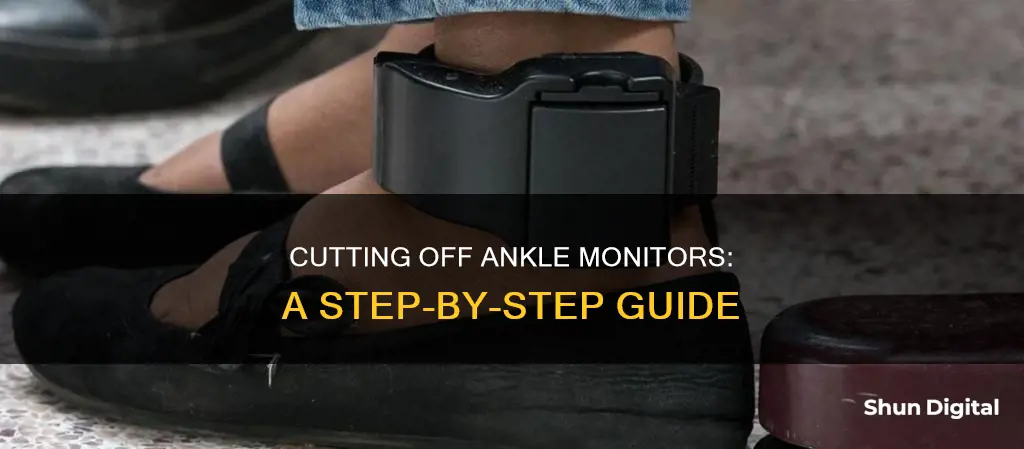
Global positioning system (GPS) ankle monitors are often used to monitor the location of individuals under house arrest or probation. While they can interfere with an individual's life, ability to travel, and work, removing them without legal permission is illegal and can result in jail time. The only legal way to have a GPS ankle monitor removed is to hire a lawyer to file a motion to modify the terms of probation or house arrest. This process can be complex and may depend on the judge's decision and the specific circumstances of the case.
| Characteristics | Values |
|---|---|
| Types of ankle monitors | CAM (continuous alcohol monitor) and GPS (global positioning system) |
| How to remove | Hire a lawyer to file a motion to modify the terms of probation |
| When to ask a judge to remove the ankle monitor | First-time DUI, domestic battery where contact is necessary to take care of a child, both CAM and GPS have been ordered |
| When not to ask a judge to remove the ankle monitor | Domestic battery case where the charge has not been filed, out on bond for a crime involving alcohol and have not taken steps to address it |
What You'll Learn

Legal process of removing a GPS ankle monitor during probation
The legal process for removing a GPS ankle monitor during probation can vary depending on the jurisdiction and the specific conditions of your probation. However, here is a general overview of the process:
Firstly, it is important to understand that a GPS ankle monitor is typically court-ordered and cannot be removed until the court-approved date. In some cases, the court may set a specific duration for the monitoring, after which you may be able to request its removal. It is always advisable to consult with your probation officer and seek their recommendation before initiating any legal process. If they are amenable to removing the monitor, it may be a simpler process.
If you wish to pursue legal action to remove the monitor, you will need to hire an attorney to file a motion to modify the terms of your probation. This typically involves demonstrating to the court that you no longer require the monitor and that your probation conditions have been satisfactorily met. The opinion of your supervising officer may carry weight in this process, particularly if the person you are prohibited from contacting lives in the same community as you. Ultimately, however, the decision rests with the judge who placed you on probation.
It is important to note that attempting to remove or damage the GPS ankle monitor without following the legal process is a serious offence and can result in further legal consequences. Each jurisdiction may have specific laws regarding the removal of court-ordered GPS monitoring devices, so it is essential to consult with a legal professional familiar with the laws in your area.
In certain circumstances, your criminal defence attorney may be able to file a motion to remove mandated electronic monitoring, particularly during the pre-trial phase and for those without a criminal history. This is known as a Motion to Modify Pretrial Release Conditions (GPS).
Removing Rubber Covers from Your ASUS Monitor Easily
You may want to see also

Types of ankle monitors: CAM and GPS
There are two types of ankle monitors: CAM (continuous alcohol monitor) and GPS (global positioning system). Depending on the charges against you, you may be required to wear one or both of these monitors. These devices can be extremely inconvenient and disruptive to your life, travel, and work.
A CAM ankle monitor is a device that is attached to the ankle and functions similarly to a breathalyzer. It provides 24/7 supervision, testing the wearer's perspiration for alcohol every 30 minutes. This ensures that the wearer does not consume any alcohol. The primary bracelet offered is the SCRAM CAM bracelet.
On the other hand, a GPS ankle monitor provides real-time tracking of a person's location 24/7. Judges often order "exclusion zones" or "house arrest" for individuals wearing GPS monitors. Exclusion zones are areas that the wearer is prohibited from entering, such as the home or workplace of the victim in a criminal case. Individuals on house arrest are typically only allowed to travel between their home and their place of work.
GPS ankle monitors are usually about the size of a pager and are strapped to the ankle with a tamper-proof band. They use GPS technology to determine the wearer's location and transmit a signal to a base unit, typically located in the home. If the wearer goes outside the designated area, the device vibrates and emits a loud tone, notifying them that they are about to violate the conditions of their release. If they do not return to the designated area, the device sends an alert to the authorities.
Ankle monitors can be extremely disruptive to daily life and can interfere with your ability to work and take care of your family. They are typically used for individuals who are considered a danger to the community or a flight risk.
Monitoring Propane Gas Usage: Efficient Ways to Track Consumption
You may want to see also

Restrictions of a GPS monitor
A GPS ankle monitor is a court-ordered device that tracks an individual's location and movements. It is typically used as an alternative to incarceration, allowing offenders controlled freedom while ensuring they comply with court-ordered movement restrictions. Here are some restrictions and limitations associated with GPS ankle monitors:
- Restricted Movement and Geographical Limits: One of the primary restrictions of a GPS ankle monitor is limited mobility and geographical boundaries. The court sets specific areas that the individual must stay within, often restricting them to their home address or a designated perimeter. If the individual attempts to leave the court-designated area, the monitor will physically alert the wearer and notify the authorities. In some cases, travel outside the home may be permitted for specific purposes, such as work, religious services, medical appointments, or court-approved meetings. However, these trips are usually scheduled in advance, and deviations may result in consequences.
- Scheduled Check-Ins and Reporting: Individuals wearing GPS ankle monitors are typically required to meet with their probation or parole officers at scheduled times. They may also need to regularly report to a community control officer or their supervising authority to ensure compliance with the terms of their release.
- Abstinence from Drugs and Alcohol: Abstinence from drugs and alcohol is often a mandatory condition for those wearing GPS ankle monitors, especially if the offence is related to substance abuse or driving under the influence (DUI). In some cases, the monitor may be equipped with alcohol detection capabilities, analysing the wearer's sweat for alcohol content. Non-compliance with these restrictions can lead to serious consequences.
- Curfew and House Arrest: GPS ankle monitors are commonly used to enforce curfews and house arrest conditions. The monitor vibrates and emits a loud tone if the wearer goes outside the designated area during the restricted time. Failure to comply with these restrictions will result in alerts to the monitoring station and potential law enforcement intervention.
- No Tampering or Removal: GPS ankle monitors are designed to be locked in place and cannot be removed until the court-approved date. Attempting to remove, tamper with, or damage the device is strictly prohibited. Most monitors have built-in sensors that detect any interference and automatically notify law enforcement agencies. In some jurisdictions, the unauthorised removal of a GPS monitor is considered a felony.
- Compliance with Court-Ordered Conditions: The terms and conditions associated with GPS ankle monitors vary depending on the individual's case and the court's rulings. These conditions may include adhering to a specific schedule, avoiding certain people or locations, or complying with other restrictions imposed by the court. Non-compliance with any of these conditions can result in legal consequences, including additional penalties, revocation of parole, or jail time.
Blind Spot Monitor: Toyota's Worthy Safety Investment
You may want to see also

Alternatives to a CAM monitor
There is no alternative to a GPS monitor, the only option is to convince a judge that the monitor should not be ordered or removed. GPS monitors are used for 24/7 location monitoring, often for those on house arrest or with "exclusion zones" that they are not allowed to enter.
Am I Being Watched on Facebook?
You may want to see also

What happens if you violate the conditions of the ankle monitor
Ankle monitors are used to allow people to remain free while awaiting trial, provided they meet certain conditions set by the court. The terms and conditions can vary depending on the individual's situation. They might include sticking to a specific area, avoiding certain people, or adhering to a curfew. Ankle monitors are usually used for people who are considered a danger to the community or a flight risk.
If you violate the conditions of your ankle monitor, you may face additional penalties, including jail time. For example, if you are mandated to stay within a certain radius of your home and you leave this area, your ankle monitor will first vibrate and emit a loud tone, notifying you that you are about to breach the set conditions. If you do not return to the designated area, the device will send an alert to the authorities, and you may be sent back to jail.
In addition to location tracking, ankle monitors can also be used to ensure a person isn't violating the terms of their sentence with regards to sobriety. A Secure Continuous Remote Alcohol Monitor (SCRAM) bracelet can detect alcohol in a person's sweat, alerting authorities if the person consumes alcohol, which may be prohibited as a condition of their release.
The consequences of violating the conditions of an ankle monitor can be serious and may result in a return to jail, higher bail, or other penalties. It is important to understand the specific conditions and restrictions associated with the ankle monitor to avoid any violations.
Monitoring iPad Battery Usage: Tips and Tricks
You may want to see also
Frequently asked questions
You can get an attorney to file a motion to modify the terms of your probation. You can also hire a lawyer to seek a modification of terms to remove it.
You can request to get it removed after some time, like six months. You can also get an attorney to file a motion to modify the terms of your probation.
Yes, alternatives to a CAM monitor include random drug and alcohol testing, a remote breath device called SoberLink, and entering into an inpatient treatment program.







